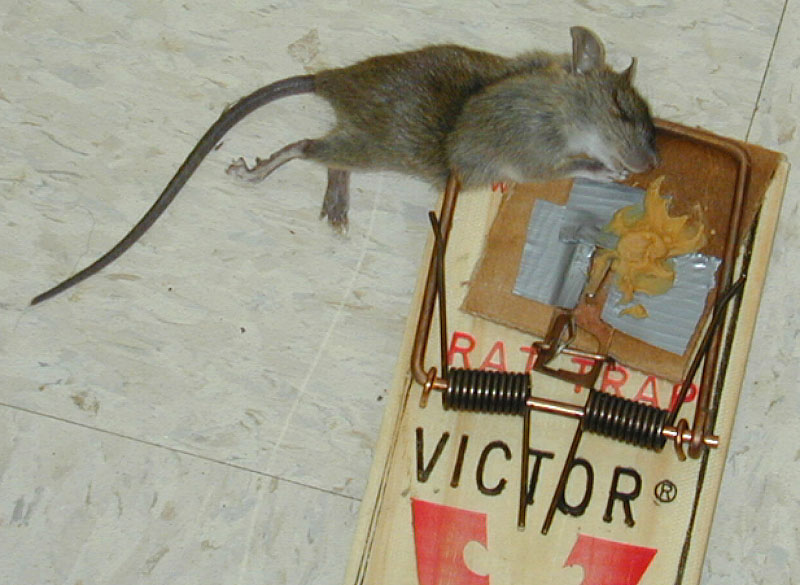There are few household maintenance issues as alarming or frustrating as hearing rodent footsteps in the ceiling or attic. This happened to me earlier this year in my home, and recently my wife’s office has been hearing the pitter-patter of tiny feet above the ceiling tiles at their place of work.
At my home the culprit turned out to be a squirrel that had loosened mortar on the roof/siding interface on my roof. A 1/2 inch gap is all that a squirrel needs to get into an attic. In my wife’s office the most likely culprits are roof rats based on where the noises are coming from. Squirrels are especially destructive through their chewing activities, sometimes opening large holes in soffits and fascia, and chewing on wires inside the structure.

A professionally installed one-way door for squirrels. The squirrel can get out, but can’t get back in.
Squirrel control generally requires installing a one-way door or repeater trap on the roof where squirrels are gaining entry. There are no toxic baits labeled for squirrels, nor should baiting ever be attempted for these animals. Because of the challenges of gaining access to the roof, and knowing how best to set traps and doors in a variety of odd situations, and the complication that comes with squirrels and their babies, it’s best to hire a professional. Personally I know my limits when it comes to scurrying around roofs, and my roof is too steep for me to get around safely. I hired a professional to install a one-way door at the suspected entry point and problem solved.
Roof rats are quite common in our urban communities in east Texas and throughout the south. They are not a problem to be ignored. Rats can cause significant problems in attics where they contaminate stored items and may chew on wiring with the potential to start a fire.
Should you experience a roof rat infestation in your home, the first step is to inspect and seal the most likely entry points. Too many people ignore this step, and end up failing to eliminate their problem. For most homes the most likely entry points include gaps around the garage door, venting and flashing on the roof, and ground-level gaps under and around siding. If you have an older home with a crawl space, there may be numerous possible entry points under the home.
A roof rat can enter a home through a gap under a door as narrow as 1/2 inch, or a hole the size of a quarter. So rodent proofing should be thorough. Depending on the site, holes and gaps can be filled with cement, low expansion-expanding foam (careful not to use too much) and brass or stainless steel wool (an excellent, non-staining product that is even easier to use is called Xcluder). If you’re not up to climbing your roof, you might want to employ a pest control professional for the pest proofing step.

Snap traps are fast and humane. Suitable baits for roof rats include seeds, fruit, chocolate, peanut butter, and even cotton balls (for nesting material). This rat gained access to the home through an attic.
Controlling the rodents inside your home is the second step. The two basic control options include snap traps or bait. Snap traps are fast and humane (compared to glue boards), but they require some skill in setting and must be checked often (daily is best) to remove the dead rats (if this isn’t your cup of tea, hire a professional). The most common mistake with snap traps is not putting out enough traps. If you think you have one rat in your attic, you probably have more. A good rule of thumb is to triple the number of traps that you think you need, and keep them freshly baited.
In an attic, place snap traps wherever you find droppings, and usually along rafters or next to stored boxes. Because access to most attics is limited to central areas of the attic, trapping usually is also restricted to a small portion of the attic. For this reason, sometimes pre-baiting (putting unset traps out with food) for several days to a week might be desirable to acclimate the rats to coming to these central locations, that they might otherwise avoid.
Rodenticides are my second choice for rodent control because of the potential for dead rats in inaccessible areas and the (usually very low) chance for secondary poisoning of pets or predatory birds. Usually produced as solid blocks with wax to make them weather resistant, baits can be an effective tool, especially when there are more than just a few rodents. In my opinion, the big disadvantage of baiting is that the rats can die anywhere in the house (don’t believe anyone who tells you baits “make the rats thirsty and they go outside to die”). And this inevitably leads to dead animal smells and sometimes, indoor fly infestations.
Baits should always be secured within a bait station or on a wire so that they can be retrieved later, when control is achieved. Baits thrown into the corners of an attic, and which are not eaten, can create a stored product pest infestation later. Most rodent baits sold today in the U.S. are required to be secured in a child-resistant bait station, and can only be used in or around a structure. Place bait stations in areas where droppings are found, or near suspected rodent entry points.
Rodent control can be challenging, and whole books can and have been written about rodent control around homes. If you are not sure what kind of rodent might be infesting your attic, or not sure you’re up to doing the dirty work of rodent control, don’t hesitate to hire an experienced professional. For more information about roof rats and their control, click here. And for information about tree squirrels in and around homes, click here.
